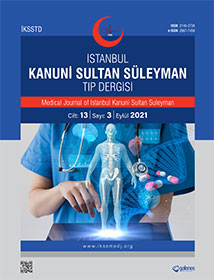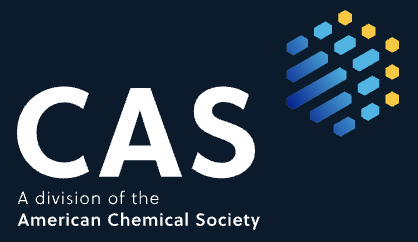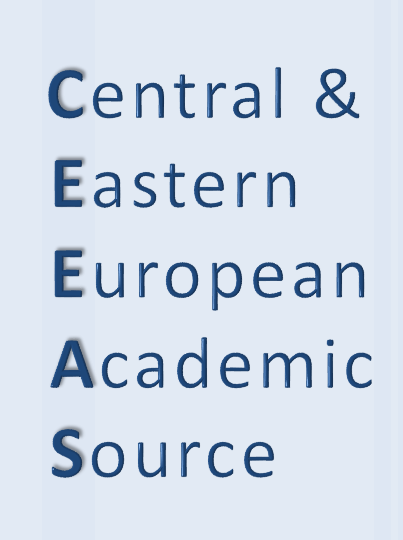Quick Search
Volume: 13 Issue: 3 - 2021
| LETTER TO THE EDITOR | |
| 1. | Percutaneous Tracheostomy in COVID-19 Patients Ayça Sultan Şahin, Ebru Kaya doi: 10.4274/iksstd.2021.62533 Pages 160 - 161 Abstract | |
| RESEARCH ARTICLE | |
| 2. | COVID-19 in Hemodialysis Patients: Clinical Features, Results, and Factors Associated with Mortality Can Sevinç, Özge Timur, Recep Demirci doi: 10.4274/iksstd.2021.80958 Pages 162 - 169 INTRODUCTION: Globally, coronavirus disease-2019 (COVID-19) has affected the elderly population and patients with multiple comorbid diseases. Hemodialysis (HD) patients are at risk of contracting COVID-19 due to immunosuppression caused by chronic kidney disease, advanced age, and existing comorbid diseases. We retrospectively studied the clinical characteristics of total of 121 HD patients with COVID-19. METHODS: Of the 121 patients, 61 (51%) and 59 (49%) were female and male, respectively. Mean age of the patients was 61 ± 14. The most common comorbid disease among the patients was hypertension, followed by coronary artery disease and diabetes mellitus. The most common complaints were cough, myalgia, and shortness of breath. RESULTS: Of the 121 patients, 61 (51%) and 59 (49%) were female and male, respectively. Mean age of the patients was 61 ± 14. The most common comorbid disease among the patients was hypertension, followed by coronary artery disease and diabetes mellitus. The most common complaints were cough, myalgia, and shortness of breath. DISCUSSION AND CONCLUSION: This study contributes to literature by determining biomarkers to predict mortality due to COVID-19 infection in high-risk and vulnerable HD patient population. |
| 3. | Comparison of the Cement Volume Delivered During Percutaneous Vertebroplasty/Kyphoplasty Interventions with Volumes Calculated on Postoperative Radiological Images: A Clinical Experience Ahmet Tolgay Akıncı, Baris Chousein doi: 10.4274/iksstd.2021.79553 Pages 170 - 176 INTRODUCTION: Although many researchers have investigated the cement volume delivered during vertebroplasty (VP) and kyphoplasty (KP) as a factor affecting outcomes, to the best of our knowledge, none of these investigations compared this cement volume with those of postoperative radiological images. This study aims to compare the cement volume delivered during VP and KP with the volumes calculated on postoperative radiological images to assess their level of compatibility and reflection for the actual quantity of cement. METHODS: In a single-center, retrospective observational study, clinical data and radiological images of a total of 49 patients, among whom 28 and 21 underwent VP and KP, respectively, for a total of 67 vertebral levels, were examined. The median age (interquartile range) was 70 (17) years; 39 (79.6%) patients were females and 10 (20.4%) patients were males. Data were analyzed and differences in the volumes were assessed. RESULTS: For the overall volume, there was no statistically significant difference (One sample t-test, p > 0.05). The KP interventions had a significantly higher mean volume difference when compared to the VP interventions (Two samples t-test, p < 0.01, d = 0.785). DISCUSSION AND CONCLUSION: Our results showed consistency in the overall volumes of cement; however, KP interventions had a significantly higher mean volume difference. |
| 4. | Clinical Dosimetric Comparison of Three Radiotherapy Techniques for Left-Sided Breast and Lymphatic Irradiation Elif Eda Özer, Gülşen Pınar Soydemir, Meltem Kırlı, Gülşah Özkan doi: 10.4274/iksstd.2021.50103 Pages 177 - 183 INTRODUCTION: We compared the dosimetric differences between three treatment modalities, including three-dimensional conformal radiation therapy (3D-CRT), intensity-modulated radiotherapy (IMRT), and volumetric intensity-modulated arc therapy (VMAT) planning methods, for the breast tangential field and lymphatic draining region following breast radiotherapy in ten patients with left-sided breast carcinoma. METHODS: For each patient undergoing breast-conserving surgery and dissection of selected axillary lymph nodes, 3D-CRT, IMRT, and VMAT were planned. Dosimetric parameters of target volumes and organs at risk (OAR) were compared. Planned target volume (PTV) was the whole breast and lymphatic region. A total of 50 Gy was administered at the rate of 2 Gy/fraction to all patients. RESULTS: The dose received by 2% of the PTV for breast radiotherapy was lowest in IMRT planning (p = 0.001); the dose for supraclavicular region was lowest in VMAT (p = 0.001). The dose received by 95% and 98% of the PTV for the axillary region was lowest in 3D-CRT (p = 0.002 and 0.045, respectively). The doses of OAR, including the heart, ipsilateral and contralateral lung, and contralateral breast were lowest in 3D-CRT planning (p < 0.01). IMRT showed the lowest monitor units (p = 0.001). DISCUSSION AND CONCLUSION: All three planning methods met the dosimetric criteria in patients with breast and axilla radiotherapy indications after breast-conserving surgery. Although each treatment technique has its own advantages and disadvantages, 3D-conformal plans may provide a lower dose coverage for the OAR, which is important for long-term side effects and secondary cancer development. |
| 5. | Differences of Accumulated Heavy Metal Levels in End-Stage Liver Disease, Wilson’s Disease, and Other Etiologies Sinan Hatipoğlu, Abuzer Dirican, Mustafa Ateş, Muhammer Özgür Çevik, Önder Yumrutaş, Muhammet Ali Işık, Sezai Yilmaz doi: 10.4274/iksstd.2021.82712 Pages 184 - 193 INTRODUCTION: End-stage liver disease (ESLD) is a devastating condition, which leads to liver transplantation (LT). There are various proposed predisposing factors for ESLD. A significant proportion of ESLDs is of undetectable (cryptogenic) origin. Accumulation of heavy metals is a proposed but not thoroughly researched predisposing factor for ESLD. In this study, we measured the concentration of accumulated heavy metals in the explanted liver tissue of ESLD patients. Apart from various accompanying etiologies, such as rare hereditary diseases, infections, and tumors were also evaluated. METHODS: This prospective study aimed to evaluate the concentrations of heavy metals in the explanted liver of consecutive patients with ESLD and different etiologies who underwent elective and/or emergency LT. Bioaccumulation of nine heavy metals (Hg, As, Zn, Cr, Pb, Cu, Ni, Mg, and Fe) was evaluated by atomic absorption spectrophotometer in the explanted liver tissue of ESLD patients. Also, histopathologies of explanted livers and etiologies of patients were evaluated using data from histopathological techniques, medical records, or genetic counseling processes. RESULTS: The male/female ratio was 33: 15. The results of our study showed no statistical significance in terms of total heavy metal levels in the explanted livers (p > 0.05), including patients with cryptogenic etiology. However, four patients with Wilson’s disease had copper levels of 250 uq/g dried liver tissue. Histopathological examinations of explanted livers revealed that four (8%) patients had Wilson’s disease, one (2%) patient had tyrosinemia, 15 (31%) patients had unknown/undetectable (cryptogenic) etiology, 24 patients had viral infections (20 had hepatitis B virus infection, one had hepatitis C virus infection, three had multiple viral infections at once), one patient had a metastatic tumor, one patient had an unidentified autoimmune disease, and one patient had polycystic liver disease. DISCUSSION AND CONCLUSION: Accumulated total heavy metal levels in explanted livers of ESLD patients do not appear to be a differential diagnosis tool, except the copper levels for Wilson’s disease. More research is needed to further elucidate the different roles of heavy metal concentrations in both normal and disease states of heavy metals in the liver. |
| 6. | R-CHOP Chemotherapy with a Rituximab Biosimilar (Redditux®) for Patients with de novo Diffuse Large B-cell Lymphoma: First Preliminary Results of a RealLife Single-Center Experience from Turkey Murat Özbalak, Metban Mastanzade, Özden Özlük, Tarık Onur Tiryaki, Ezgi Pınar Özbalak, İpek Yonal-Hindilerden, Ali Yılmaz Altay, Gülçin Yeğen, Mustafa Nuri Yenerel, Meliha Nalçaci, Sevgi Kalayoğlu Beşışık doi: 10.4274/iksstd.2021.35761 Pages 194 - 198 INTRODUCTION: The introduction of rituximab significantly improved the response rates of patients with diffuse large B-cell lymphoma (DLBCL). The rituximab biosimilar Redditux® (RED) was approved in Turkey for all indications of the reference molecule MabThera® (MBT) in March 2018. The aim of this retrospective analysis was to evaluate the efficacy and safety of RED in de novo DLBCL. METHODS: All patients diagnosed with DLBCL (n = 54) according to the World Health Organization criteria and followed up at the Hematology Division of İstanbul University, İstanbul Medical Faculty, from February 2019 to February 2020 were included in our analysis RESULTS: Median age of the patients was 59 years (range: 17-79) and 57% of the patients were males. Median follow-up time was 10 months (range: 4-15). The overall response rate at the end of the treatment protocol was 86%, with 37 complete responses and 8 partial responses. The 12-month estimated overall survival was 76.8% [95% confidence interval (CI): 0.54-0.89] and the progression free survival was 78.5% (95% CI: 0.59 - 0.89). Adverse events were reported in 53% (n = 29) of the patients. The most common adverse event was grade 2 infusion reactions. There was no serious adverse event that instigated the cessation of the drug. Seven patients died during the follow-up due to central nervous system disease (n = 3), progressive disease (n = 2), and unknown causes (n = 2). DISCUSSION AND CONCLUSION: Compared to the initial historical trial of MBT, the complete response in stage 2, 3, and 4 patients seem to be slightly lower (69% vs. 75%), although the overall response rates are quite similar (86% vs. 82%). However, large prospective controlled studies and more real-life data with longer follow-up are needed to document the non-inferiority and safety of RED compared to MBT. |
| 7. | Evaluation of Tube Thoracostomy Interventions Applied in the Emergency Department Hüseyin Ergenç, Banu Karakuş Yılmaz doi: 10.4274/iksstd.2021.44265 Pages 199 - 206 INTRODUCTION: This study examined the demographic and clinical characteristics and complications of patients undergoing tube thoracostomy (TT) in the emergency department (ED). METHODS: This retrospective study included a total of 263 patients who underwent TT performed by emergency physicians within a 2-year study period in the ED of University of Health Sciences Turkey Şişli Hamidiye Etfal Training and Research Hospital. Demographic characteristics of the patients who underwent TT, diagnosis on which the indication for TT was based, mechanisms responsible, morbidities, and complications observed were examined. RESULTS: The mean age of the patients included in the study was 35.89 ± 17.47 years and 224 (85.2%) patients were male, while 39 (14.8%) patients were female. Indications for TT in the ED were pneumothorax in 174 patients, hemopneumothorax in 74 patients, hemothorax in 10 patients, and empyema/effusion in 5 patients. TT was performed due to non-traumatic causes in 152 (58%) patients and traumatic causes in 111 (42%) patients. The non-traumatic causes were spontaneous pneumothorax in 134 patients, iatrogenic in 12 patients, and empyema/effusion secondary to comorbidities and infections in 5 patients. Complications due to TT occurred in only eight (3%) patients. DISCUSSION AND CONCLUSION: The most common indication for TT in the ED was pneumothorax, whereas the main etiology was non-traumatic causes. The application of TT procedures by emergency physicians did not increase the rate of complications since a complication rate of 3% was associated with the procedure. |
| 8. | Wilms Tumor: Review of the Current Literature with 32 Years of Experience of a Single Center Seyithan Özaydın, Birgül Karaaslan doi: 10.4274/iksstd.2021.81557 Pages 207 - 212 INTRODUCTION: Wilms Tumor (WT) is the most common renal tumor of childhood, usually seen between the ages of 2-4 years. The survival rate is reported as 90% in non-metastatic cases and 75% in metastatic cases. In the study, it was aimed to review the current literature by presenting 32 years of WT experiences of a single center. METHODS: The files of 70 patients who underwent WT surgery in our Pediatric Surgery clinic between January 1988 and December 2019 were retrospectively reviewed. RESULTS: Sixty-two of the 70 cases were unilateral and 8 were bilateral. 33 (53.2%) of unilateral cases were female, 29 (46.7%) of them were male, 5 (62.5%) of bilateral cases were female and 3 (37.5%) of them were male. The mean age was determined as 33.6 months (8-62) in unilateral cases and 25.4 months (12-54) in bilateral cases. WAGR Syndrome was found in one case. 5 of the cases were Stage I, 22 were Stage II, 19 were Stage III, 16 were Stage IV and 8 were Stage V. The most common metastasis was detected in the lung at the rate of 56% (n=9/16). While anaplasia was judged histopathologically in 12 (17.1%) of the cases, recurrence was detected in 10 (14.2%) cases. One case died peroperatively and 13 patients died during follow-up. 8 (61.5%) of those who were lost were undesirable in histopathology including anaplasia. The survival rate in our series was determined as 91% in positive cases and 33% in unfavorable cases. DISCUSSION AND CONCLUSION: Future efforts in the treatment of WT should be to create national and international integrated data screening indexes in order to increase recovery, reduce chemotherapy toxicity and contribute to innovations in treatment, especially in high-risk cases, as in our series. |
| 9. | A Comparison of Drug Regimens and Analysis of Effective Factors for Blood Transfusion and Intervention in Spontaneous Rectus Sheath Hematomas Ahmet Sürek, Mehmet Abdussamet Bozkurt, Burak Altunpak, Turgut Dönmez, Eyüp Gemici, Sina Ferahman, Hüsnü Aydın, Ali Kocataş, Mehmet Karabulut doi: 10.4274/iksstd.2021.22043 Pages 213 - 221 INTRODUCTION: Rectus sheath hematomas (RSH) are mostly observed in older patients with a high number of comorbidities. The use of anticoagulants is the most common risk factor for the disease. Our study aimed to determine the effect of the drug regimens and analyze the risk factors for blood transfusion and intervention in cases of RSH. METHODS: The records of 46 patients who had been treated for RSH between January 2015 and March 2020 were analyzed retrospectively. The demographic data, drug usage, tomography findings, clinical courses, and morbidity and mortality rates of the patients were recorded. The findings were compared according to the drug regimens, and the risk factors for blood transfusion and intervention were determined. RESULTS: The mean erythrocyte transfusion (3.61 U), number of patients who underwent erythrocyte transfusion (77%), mean hematoma size (10.07 cm), and length of hospital stay (7.53 days) were higher in Group 1 (only using acetylsalicylic acid) patients (p = 0.002, p = 0.011, p = 0.016, and p = 0.004, respectively). The common risk factors for blood transfusion and intervention, however, were low hemoglobin levels, contrast extravasation and type-3 hematoma on computed tomography (CT), and long hospital stay. DISCUSSION AND CONCLUSION: RSH are usually treated conservatively. Blood transfusion, vascular embolization, and/or surgical treatment may be required. Only acetylsalicylic acid use, low hemoglobin levels, long hospital stay, and contrast extravasation, and type 3 hematoma on CT were associated with more blood transfusion and intervention. |
| 10. | A Rare Case Series: 32 Years of Congenital Lumbar Hernia Experiences of a Single Center Seyithan Özaydın, Cemile Beşik doi: 10.4274/iksstd.2021.81488 Pages 222 - 226 INTRODUCTION: Congenital lumbar hernia (CLH) is a rare pathology accompanied by many anomalies. Early surgery is recommended due to the risk of possible complications and the need for patch reinforcement at an advanced age. The aim of the study was to present our clinical experience, which is a rare series. METHODS: The files of CLH cases operated in our clinic between 1988 and 2020 were retrospectively analyzed. The cases were examined in terms of their demographic characteristics, examinations, additional anomalies, surgery notes, and follow-up processes. RESULTS: Eight of the nine patients were under one year old, and one was three years old. 6 (66.6%) of the cases were female, 3 (33.3%) were male and all were unilateral. The hernia was on the right in 3 cases (33.3%) and on the left in 6 cases (66.6%). Scoliosis and rib deficiency were detected in 4 cases evaluated as lumbo-costo-vertebral syndrome, and hemivertebra in one case. One of these patients had renal agenesis and two had ectopic kidneys. All of the cases were of the Grynfeltt-Lesshaft type originating from the upper lumbar triangle, and there was retroperitoneal fat in the sac in one case, kidney in one case, colon in three cases, and spleen in one case. In our cases without strangulation findings, the defect width was between 3 and 6cm; all could be closed primarily without patch reinforcement. None of the patients developed complications or recurrence. DISCUSSION AND CONCLUSION: Operation of CLH cases as soon as possible after the diagnosis by making the necessary consultations prevents the development of complications and provides primary closure. |
| 11. | Evaluation of the Clinical Findings and Glycemic Parameters in Patients Newly Diagnosed with Diabetes Mellitus after Being Infected with Coronavirus Disease-2019 İskender Ekinci, Gülden Anataca, Mitat Büyükkaba, Ahmet Çınar, Hanise Özkan, İrem Kıraç Utku, Murat Akarsu, Abdulbaki Kumbasar, Ömür Tabak doi: 10.4274/iksstd.2021.72677 Pages 227 - 235 INTRODUCTION: The aim of this study was to analyze patients newly diagnosed with diabetes mellitus (DM) after coronavirus disease-2019 (COVID-19) infection and compare them with type 2 DM patients in terms of clinical findings and glycemic parameters. METHODS: This retrospective case-control study was conducted with patients with post-covid DM (PCDM) and newly diagnosed type 2 DM RESULTS: Fifty eight patients with PCDM and 57 patients with type 2 DM were included in the study. While 73 of the subjects were male, the mean age of the all subjects was 49.1 ± 12 years. The two groups were similar in terms of age, gender distribution, frequency of smoking and family history of DM, and mean body mass index (p > 0.05). Dry mouth, polyuria, polydipsia, and weight loss were more common in patients with type 2 DM, whereas fatigue was more common in patients with PCDM (p < 0.05). Serum creatinine levels were higher in patients with PCDM than in those with type 2 DM (p < 0.05), whereas glycosylated hemoglobin A1c, C-peptide, alanine transaminase, aspartate transaminase, lipid levels and microalbumin/creatinine ratio in spot urine were not different between the two groups (p > 0.05). One of the microvascular complications, neuropathy, was more common in patients with type 2 DM (p < 0.05). The frequency occurrence of diabetic ketoacidosis at the time of diagnosis of DM was similar in the groups (p > 0.05). DISCUSSION AND CONCLUSION: In this study, PCDM patients were found to be different from type 2 DM in terms of symptoms and signs, but very similar to type 2 DM patients in terms of metabolic parameters. |
| 12. | Retrospective Analysis of Colonoscopic Polypectomy Results at University of Health Sciences Turkey Kanuni Sultan Süleyman Training and Research Hospital Aysun Temel İncebacak, Kader Irak, Ömür Tabak, Abdulbaki Kumbasar doi: 10.4274/iksstd.15046 Pages 236 - 240 INTRODUCTION: Colorectal polyps are tissue masses originating from the mucosa and submucosa in the gastrointestinal system and extending into the intestinal lumen. Since polyps have a risk of cancer, the detected polyp should be removed by colonoscopy and examined histopathologically. In our study, we evaluated polyps that were removed colonoscopically and underwent histopathological examination. METHODS: 2,267 colonoscopy reports made in the Gastroenterology Endoscopy Unit at University of Health Sciences Turkey Kanuni Sultan Süleyman Training and Research Hospital between 2013 - 2015 were retrospectively analyzed. Patients were analyzed according to polyp incidence, male-female ratio, average age, polyp location and polyp type. RESULTS: Colonoscopy was performed on 2,267 patients for various reasons, and polyps were found in 302 (13.3%). One hundred seventy three (57.3%) of the cases were rectosigmoid, 67 (22.7%) descending colon, 47 (15.6%) transverse colon, 35 (11.6%) ascending colon and 13 (4.3%) polyps were seen in the cecum. 168 (55.6%) adenoma, 120 (39.7%) tubular adenoma, 41 (13.6%) tubulovillous adenoma, 7 (2.3%) villous adenoma, 30 (7%) inflammatory polyps, 10 (3.3%) were mucosal, 3 (1%) were serrated, 2 (0.7%) were lipomas. 52 (17.2%) of the cases were determined as adenocarcinoma and 71 (23.5%) as hyperplastic polyps. According to their size, 227 (75.2%) of the polyps were below 1 cm and 75 (24.8%) were over 1 cm. DISCUSSION AND CONCLUSION: The results in our study were found to be compatible with the literature. Since it is impossible to determine the risk endoscopically, all polyps detected during endoscopy should be removed or coagulated and followed. |
| 13. | Can Intraabdominal Esophageal Length Measurement Predict Gastroesophageal Reflux in Childhood Caustic Esophageal Strictures? Hasan Demirkan, Tugrul Tiryaki doi: 10.4274/iksstd.2021.33154 Pages 241 - 245 INTRODUCTION: In childhood age group, caustic esophageal burn remains an important health issue in developing countries. We aimed to prospectively investigate the relationship between the intraabdominal esophageal segment (IES) shortening and gastroesophageal reflux disease (GERD) in children with caustic esophageal stenosis. METHODS: Between January - 2012 and January - 2013, 16 children were followed up in a pediatric surgery center in Turkey for caustic substance intake. At the admission to hospital, all patients were evaluated for esophageal burn grading by esophagoscopy. The IES length was demonstrated by ultrasonography (USG) at the admission and 3rd month of ingestion. Esophageal stricture was explored at the 3rd week by esophagus-stomach-duodenum radiography. 24-hour-pH monitoring was performed at the 3rd month of intake for GERD. RESULTS: Nine (56%) patients of the study group were male. Mean age was 5.06 ± 4.95 years. Grade 1 caustic esophageal burn was detected in 3 (19%) patients, grade 2a in 4 (25%) patients and grade 2b in 9 (56%) patients. Esophageal stricture was detected during the esophagoscopy of 3 patients with grade-2b burns, and the IES length of them was found to be shortened in the 3rd month. GERD was detected in 2 patients in 24-hour-pH monitoring. One of them had grade 1 and the other had grade-2b burn. There was no significant relationship between IES length shortening and GERD. DISCUSSION AND CONCLUSION: The presence of caustic esophageal stricture is a risk factor for GERD. In these patients, exploring shortening of the IES length with USG might be helpful for prediction of GERD. By this way, short and long-term complications of caustic burns can be avoided by early diagnosis and treatment. |
| 14. | The Prevalence of Sacroiliac Joint Dysfunction Among Medical Students and Evaluation of Relevant Clinic Parameters: A Cross-Sectional Study Ahmet Kıvanç Menekşeoğlu, Tuğba Şahbaz doi: 10.4274/iksstd.2021.02259 Pages 246 - 251 INTRODUCTION: Although sacroiliac joint (SJ) dysfunction (SJD) causes low back pain, studies determining its prevalence and characteristics in the healthy population are limited. The aim of this study is to evaluate the prevalence of SJD and associated clinical parameters in medical faculty students. METHODS: 230 participants were included in the study. Participants were evaluated with specific tests for SJD. The low back pain of the participants was evaluated with visual analog scale, presence of hypermobility with Beighton criteria, and disabilities due to low back pain with Oswestry low back pain disability index. RESULTS: The average age of 230 people participating in the study was found to be 21.2 ± 2.1 (minimum = 18, maximum = 26). 42.6% (n=98) of the participants were female, 57.4% (n=132) were male, and the mean body mass index was calculated as 22.6 ± 3.2. SJD was detected in 17% (n=39) of the participants by physical examination. 33.3% (n=13) of those with SJD were female and 66.7% (n=26) were male. There was no significant difference among those with and without SJD with respect to age (p=0.100), body mass index (p=0.483), gender (p=0.199), aerobic (p=0.192), anaerobic exercise (p=0.054) and smoking (p=0.400) among those with and without SJD, there was no significant difference. While 53.8% (n=21) of 39 people with SJD stated that they had low back pain, this rate was found to be 18.8% (n=36) in 191 people without sacroiliac joint dysfunction. A statistically significant increase was found in the pain values assessed by visual analog scale and the Oswestry low back pain disability questionnaire values in the participants with SJD (p<0.001). DISCUSSION AND CONCLUSION: It is recommended to use physical examination methods in the diagnosis of SJD, which is a common cause of low back pain. In addition, it will be useful to evaluate factors such as leg length difference and hypermobility that may take place in the etiology. |
| 15. | Report of Five Cases and Literature Review of Psoas Abscess Cafer Özgür Hançerli, Halil Büyükdoğan, Can Eren Ünlü, Anıl Agar, Cemil Ertürk doi: 10.4274/iksstd.2021.84756 Pages 252 - 257 INTRODUCTION: To report five psoas abcess cases which we treated and review the management of psoas abscess cases. METHODS: Five patients who were diagnosed and treated with psoas abscess in our clinic between 2018 - 2019 were evaluated retrospectively RESULTS: Four patients were discharged after an average of 25 days following surgical treatments, and 1 case died on the 24th postoperative day due to sudden cardiac arrest of unknown cause. DISCUSSION AND CONCLUSION: Psoas abscesses are rare, we believe that the incidence of these cases is more frequent in recent years due to the improvements in radiological imaging methods and the fact that these tests are used more frequently by clinicians. We think that for the diagnosis of psoas abscess, it is necessary to suspect the diagnosis and keep this rare condition in mind. |






















